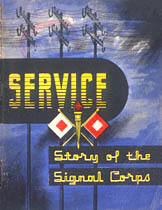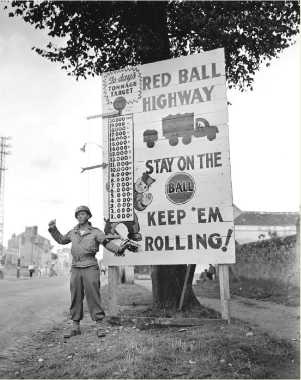Originally
published as part of a series called
G.I. Stories,
by Stars & Stripes, in Paris, in
1944-1945, the booklet below was one of several that
helped personnel understand the purpose and function of the
various ground, air, and service forces in the European
Theater of Operations (ETO).
The publication was backed by the
Orientation Branch, Information and Education Services, Hq
TSFET, and was overseen by Major General Francis H. Lanahan.
At the time, Lanahan commanded the Signal Corps as its Chief
Signal Officer. The stories in the booklet were sourced and
supplied by Lanahan's staff.
We became aware of the booklet though
MAJ (R) Richard Green, who dropped us a note this past
month, pointing us to a website where some of the content of
the original G.I. Stories was reproduced. Fortunately for
us, the part that was reproduced was the part about the
Signal Corps.
After reading it, we contacted the
website and requested their permission to condense and
reprint what they had posted on their site. To date we have
not heard back from them, and, being the leaders that we
are, especially because of the applicability of the subject
matter to our own website’s goal, we made a command decision
and decided to press on and reproduce it regardless.
Reproduced below then is a condensed
version of the story as found on the Lone Sentry website. If
you find what follows interesting, when you finish reading
it click on the Lone Sentry icon at the end. That will take you to the website itself, where you can read the
Service: Story
of the Signal Corps reprint in its entirety.
Our thanks to both Major Green and
the Lone Sentry website for this chance to retell here a
bit of our own history.
[Editor's Note: What follows is a
condensed version of the original. It has been
edited and shortened to make
it more readable and fit
the space available. To read the entire
story, please follow the instructions above—it's
well worth the read.]

 Service: Story of the Signal
Corps
Service: Story of the Signal
Corps

 For
more than 80 years, U.S. Army Signal Corps personnel have
dedicated their lives and abilities to the famous and
indomitable motto: "Get the message through." Destinies of
millions of American soldiers depended upon the skill of
Signalmen to live up to this proud pledge. Many Signalmen
made the supreme sacrifice to assure its utter
dependability.
For
more than 80 years, U.S. Army Signal Corps personnel have
dedicated their lives and abilities to the famous and
indomitable motto: "Get the message through." Destinies of
millions of American soldiers depended upon the skill of
Signalmen to live up to this proud pledge. Many Signalmen
made the supreme sacrifice to assure its utter
dependability.
From the days of smoke and
wig-wag signals, through years of pioneering, research and
constant development, the Signal Corps advanced with science
to perfect the ultra-modern organization which today employs
telephone, telegraph, radio and radar to direct and guide
the operations of America's military forces.
The story of the Signal
Corps' activity in the European Theater started long before
actual U.S. entry into the war. In addition to the military
attaché in England, a Signal Officer was assigned to the
Special Army Observer's staff in May, 1941. During this same
period, some 500 Signal Corps officers were in the U.K.
receiving training from the British in electronics.
The U.S. declaration of
war resulted in even closer British-American cooperation. On
Jan. 3, 1942, U.S. Army headquarters was established as
United States Army Forces in the British Isles, commonly
called USAFBI. By mid-year, 1942, the U.S. started its
buildup of troop strength in the U.K. for the coming
invasion of Africa and ultimately, Europe. From a few local
switchboards and motor messengers, Signal communications
expanded into a large and complex network of telephone,
teletype, radio and messenger services. Telephone
switchboards were installed in Ports, Base Sections, SOS
Headquarters at Cheltenham and at ETO Headquarters in
London. The main London switchboard consisted of 108
operating positions serving approximately 3,300 subscribers.
Shortly before D-Day,
teleprinter traffic on the SOS network reached a peak of
8,000,000 words per week and overseas traffic reached a high
of 2,000,000 groups per week. Radio facilities were readied
for the invasion and VHF stations were installed to provide
communication facilities across the Channel. Overall,
approximately 520,000 tons of Signal equipment and supplies
were sent from the U.S. to the European Theater.
The history of the Signal Corps in the ETO is a
record of constant work around the clock, 7 days a week.
Wherever battles raged, wherever armored and infantry
forces advanced, the Signal Corps installed essential
lines of communication. Signalmen dug holes, planted
poles. They climbed poles, placed wire, repaired breaks.
They operated so close to the front that Signal Corpsmen
often were atop poles stringing wire as infantrymen
plodded through the hedgerows.
A few examples:
– Working in mine fields, under constant enemy
mortar fire and occasional strafing, wire teams of the
32nd Signal Construction Bn. placed 14 miles of Spiral-4
cable between 5th Engr. Special Brigade Hq. and a
British unit on the left. This was accomplished in 48
hours although work was delayed because of mine fields
and booby traps.
– The 35th Signal Construction Bn. supplied most of the
wire communications for First Army across France,
Belgium and into Germany. From D-Day to the end of June,
1945, First Army used more than 5,000 miles of a single
type of field wire.
– The 211th Signal Depot Co. was typical of the supply
and repair outfits that landed with assault troops. Men
who first set up shop on the beaches were overwhelmed
with the quantity and complexity of supplying and
repairing Signal Corps equipment. More than 100 tons of
equipment was First Army's daily requirement. The
superior services of this outfit earned its members the
Meritorious Unit Plaque.
– Signal supplies arrived on the Continent at the rate
of 6,000 tons weekly, and were composed of approximately
31,000 separate items.
While the work of installing new stations for radio and
telephone was in progress, Signal Corps Motor Messenger
Cos. filled the breach. Messengers traveled day and
night through areas covered by exploding mines.
Casualties were suffered, vehicles knocked out. It
sometimes was necessary to destroy documents to prevent
their falling into enemy hands.
 With the opening of the
Red Ball highway, trucks loaded with Signal supplies and
equipment rolled forward in a steady stream to the
front. Not only did the Signal Corps make full use of
the highway, but Signalmen played a large part in the
operational success of the route. The communications
system set up by the Signal Corps in August, 1944,
enabled the Motor Transport Bn. to control the flow of
traffic. Directing convoys to destinations were
accomplished by a six-station radio net using SCR-399
radio sets, which were mounted in 2 1/2 ton trucks. The
990th Signal Service Co. installed and operated the
system until relieved by elements of the 3159th Signal
Service Bn.
With the opening of the
Red Ball highway, trucks loaded with Signal supplies and
equipment rolled forward in a steady stream to the
front. Not only did the Signal Corps make full use of
the highway, but Signalmen played a large part in the
operational success of the route. The communications
system set up by the Signal Corps in August, 1944,
enabled the Motor Transport Bn. to control the flow of
traffic. Directing convoys to destinations were
accomplished by a six-station radio net using SCR-399
radio sets, which were mounted in 2 1/2 ton trucks. The
990th Signal Service Co. installed and operated the
system until relieved by elements of the 3159th Signal
Service Bn.
Signalmen Jump Off With
Assault Troops
As Third Army joined First Army in the drive
across France, the speed of the advance became so great
that wire communications proved inadequate. To meet this
problem, a system of VHF radio relay equipment was
installed.
With this equipment, each station had to be beamed or
sighted like a rifle on the next station. Communication was only possible
when there were no terrain features obstructing the line of sight. To test
the concept, an area in Maine was chosen where water paths and elevation
factors were nearly identical with those of Normandy. The final radio relay
link system was developed to the point where it provided four tele-printer
circuits in addition to three radio telephone circuits.
The march across France was a nightmare to the
hard-pressed technicians in the 143rd Armd. Sig. Co., attached to the 3rd
Armored Division. By the time the Argentan-Falaise gap was closed, they had
laid more than 1,200 miles of wire lines. In the sweep across France, these
Signalmen handled an average of 1,000 radio and messenger messages daily.
Mileage rolled up by the Signal crews was eight to 10 times that covered by
the division in attack.
To save time, wires were strung along hedges and through
fences. In more open country lines were built of a type known as "rapid pole
line constructions," using small poles made of 2 x 4 timber which didn't
require digging large holes for placement. Temporary lines were strung on
lance poles, even tent poles.
When the 80th Infantry Division established
the Moselle River bridgehead against some of the stiffest opposition
encountered in the entire battle of France, Signalmen used assault boats to
reel wire across the flooded river. Clamping wires to the piers of a blasted
bridge, Signalmen tied cables to the initial strands installed above the
raging waters by engineers. This work was accomplished under constant
artillery fire by the enemy who tried desperately to knock out the bridge.
American and French forces landed in Southern France—in
what was called "Operation Dragoon"—Aug. 15, 1944. Once more, Signalmen were
among the first to go ashore. These initial elements included the 1st Sig.
Bn., which had supplied communications while the invasion force was afloat,
and the 71st, 72nd and 74th Sig. Cos., which handled the initial
communications ashore. Other elements were the 207th Sig. Depot Co., 177th
Sig. Repair Co. and three additional Signal repair teams accompanying the
three assault divisions.
Signalmen participated in the assault waves,
simultaneously setting up equipment under heavy fire. As US forces pushed
north, increasing use was made of French (telephone) lines, which were tied
into Signal Corps circuits. Much of the rehabilitation of the French
telephone systems was accomplished by American Signalmen who showed unusual
aptitude and ingenuity in rebuilding lines and switchboards destroyed by
bombs, land warfare, and German demolition.
Probably the first Signalman to enter Paris was Sgt.
Earl J. Spoon, Lamont, Okla. Driving a jeep carrying a powerful two-way
radio (SCR-193), Sgt. Spoon accompanied Col. Otto M. Low, First Army
Intelligence Officer. Their job was to report progress of operations to
First Army headquarters. Despite constant sniper fire, Spoon transmitted the
required information from the high ground adjoining the St. Lazaire railway
station, within 30 minutes of his entry into the capital.
By the end of 1944, the American wire system comprised
approximately 3,500 long distance underground cable circuits, rehabilitated
from the French. These totaled 125,000 circuit miles or 250,000 wire miles.
The Signal Corps also installed 1,200 miles of new pole lines constituting
20,000 miles of open wire.
By V-E Day, 1,916,187 wire miles of French cable and
30,968 wire miles of French open wire pole lines had been rehabilitated. The
Signal Corps had constructed 2,995 miles of open wire pole lines,
constituting 52,778 miles of wire.
In addition, 12,968 miles of pole lines were rehabilitated for use of the
Military Railway Service for operational control of rail movements. This
constituted 51,871 wire miles. Three pole line systems were constructed for
the Military Pipe Line Service, comprising 3,997 miles of construction and
4,652 miles of wire.
- - - - -
Editor's Note – A Reminder: The above is a condensed version of the full story as originally
published in 1945. The original story is several pages longer, and well
worth the read. To read the full story, click on the Lone Sentry
icon at right, below. The Lone Sentry website is where we originally found this story,
and we wish to give full credit to the folks there for letting us share this
condensed version with you. While you are at it, enjoy the many other
interesting military articles they have.

